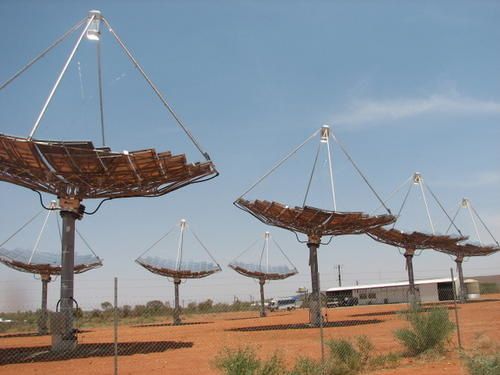energy_isere a écrit :Transparence a écrit :
(...) Reuters has reported that the Bureau of Land Management has received rights-of-way requests for more than 300,000 acres of California desert for
34 large solar plants totaling
24,000 megawatts, but analysts say many of the projects will not be completed. (...)
http://www.elynews.com/articles/2007/10 ... news01.txt
24 GWe...!!! - Même si seulement un tiers est réalisé (8 GWe), c'est déjà formidable !
J' ai quelque doute sur le chiffre !
Un peu d' esprit critique : 24000 Megawatt pour 34 centrales cela ferait une moyenne de 705 Megawatt par centrale. Or les plus grandes centrales solaires à concentration existantes font de l' ordre de 150 Megawatt.
Il doit y avoir un bug quelque part dans l' addition ou ce que rapporte Reuters.
- La taille des centrales CSP à venir est comprise entre 500 et 1000MWe (Ausra, CLFR). C'est techniquement tout à fait possible : plus de miroirs et des turbines plus grosses.
- De plus il s'agit à mon sens de 34 entreprises différentes qui ont comme projet de mettre en place des réseaux de centrale. Par exemple pour les 354 MWe des SEGS, c'est en fait une dizaine de centrales en réseau, et on en compte au final qu'une.
- Ausra : objectif de 5000 MWe (c'est une entreprise sur les 34 en question - Les autres : BrightSource energy, Solel, Acciona, Stirling Energy Systems, SkyFuel, Abengoa ... etc.)
"Sol" searching under way
By JOHN G. EDWARDS
Stephens Media
Energy developers are staking their claims to major swaths of the Mojave Desert in Nevada, California and Arizona in an effort to exploit California's growing demand for solar power. Solar panels could soon cover large sections of the Mojave Desert, thanks to California's growing demand for renewable energy sources. (Photo courtesy Gene Kolkman)
The reason? California's aggressive renewable energy portfolio standard, which forces electric utilities to use more energy from the sun, wind and other renewable resources, is a key factor, said Charles Ricker, senior vice president of BrightSource Energy, an Oakland, Calif.-based designer and builder of solar power plants. California utilities must obtain 20 percent of their power from renewable sources by 2015.
"This is just a huge market for clean power," said John O'Donnell, executive vice president of Ausra, an independent developer based in Palo Alto, Calif. This section of the Mojave Desert is "nestled between two huge electric marketplaces, Las Vegas and Los Angeles," Ricker said. Unlike Nevada, where three coal-fired power plants are planned, California prohibits investor-owned utilities from entering long-term contracts for power from coal plants because of the massive quantities of carbon dioxide coal plants emit. California intends to rely mostly on natural gas-fired plants for the power it cannot obtain from renewable energy sources, O'Donnell said.
In recent rapid-fire succession:
* Ausra promised to develop 1,000 megawatts of solar power and said it is particularly interested in sites near Boulder City.
* FPL Group, the parent of Florida Power & Light Co., said it would invest $1.5 billion in new solar thermal facilities in Florida and California.
* PG&E Corp. joined FPL and Ausra to outline their commitment to solar thermal power development during President Clinton's recent global initiative in New York. The San Francisco utility holding company said it would tap an additional 1,000 megawatts of solar thermal power over the next five years. It is negotiating with several unidentified companies. PG&E noted that the 1,000 megawatts will come on top of earlier announcements to buy 1,000 megawatts of solar power from BrightSource Energy of Oakland and Solel of Israel.
Solel is looking at three sites in the California portion of the Mojave Desert for a 553-megawatt plant that will sell power to PG&E. BrightSource Energy has filed an application for construction with the California Energy Commission for a 400-megawatt solar power plant in California's Ivanpah Valley near Primm.
Acciona Energy spurred development of solar thermal power plants in the Southwest with the successful completion of the 64-megawatt Nevada Solar One power plant in the Eldorado Valley of Boulder City, Acciona spokeswoman Lena Stinsa said. It was the largest solar thermal plant built in 16 years.
Stinsa cited other reasons for the surge in solar power development: legislative support for solar power, awareness of climate change related to greenhouse gas emissions from conventional power plants, concern about energy security and rising costs of fossil fuels. Acciona plans to build a second phase at the power plant, she said.
Reuters has reported that the Bureau of Land Management has received rights-of-way requests for more than 300,000 acres of California desert for 34 large solar plants totaling 24,000 megawatts, but analysts say many of the projects will not be completed.
Ausra's first $500 million, 175-megawatt plant will be in central California. But O'Donnell said the company intends to build others outside of California, possibly near Boulder City, and potentially in Arizona or New Mexico. Within 100 miles of the plants, Ausra intends to establish a manufacturing plant for the solar thermal units. Gov. Jim Gibbons has told Western governors that he wants to not only develop renewable power for use not only for use in Nevada but also for export, O'Donnell said. Southern Nevada is close to transmission lines leading to California.
"Transmission is the biggest challenge in figuring out where to put these plants," the Ausra executive said. Many areas with renewable energy have not been developed because they are so far from transmission lines that would carry the power to cities. If Ausra develops solar thermal plants to sell in Nevada, it would build along a planned transmission line that Sierra Pacific Resources plans to build to Las Vegas or a smaller transmission line that the Southern Nevada Water Authority proposes to build for pumping water that will be piped to Las Vegas from Northern Nevada. "Almost no place on the planet is growing faster than Clark County, Nevada," O'Donnell said. O'Donnell said Ausra can generate power from solar thermal plants for 10 cents a kilowatt hour, about half the cost of power from photovoltaic systems. Nevada Power spokesman Adam Grant said: "We're very interested in progress being made on the solar front, especially if there's any indication in the cost being driven down."
Concentrated Photovoltaics (CPV) :
(...) Problème : les cellules photovoltaïques souffrent du coût élevé de leur capteur en silicium. D'où la double innovation proposée par Gary D. Conley et Steve Horne, créateurs en novembre 2005 de l'entreprise SolFocus :
remplacer, d'une part, le silicium par un matériau dix fois plus coûteux mais au rendement supérieur, composé de germanium, d'arséniure de galium et d'indium, et concentrer la lumière, d'autre part, grâce à un système optique. L'énergie lumineuse, multipliée par un facteur 500, est ainsi focalisée sur une surface très réduite du matériau photosensible. Ce qui pourrait abaisser le coût du watt solaire plus rapidement qu'avec le silicium. (...)
Suite : LeMonde du 20 octobre 2007
http://www.lemonde.fr/web/article/0,1-0 ... 673,0.html
http://www.solfocus.com/
-----------
CSP, Algérie :
------------------------------
Je propose que l'on fasse un comparatif (avantages/inconvénients) des différentes technologies solaires qui existent aujourd'hui :
> Photovoltaïque (PV)
> Photovoltaïque concentré (CPV)
> Solaire concentré thermodynamique (STP, Solar thermal power) : tour centrale (TC), parabolic through (PT), Miroirs plans Fresnel (CLFR)
> Solaire concentré/Stirling (CSP-Stirling)
> CPV (il existe de nombreux systèmes différents :
http://wiki.oleocene.org/index.php/Sola ... a%C3%AFque - Liste d'entreprises :
http://www.ecobusinesslinks.com/solar_e ... trated.htm ) :
- rendements beaucoup plus élevés qu'avec le PV et cout du kWh plus faible.
- Mais les cellules photovoltaïques doivent être résistantes aux températures élevées = > utilisation par certaines sociétés d'éléments plus rares (Galium, Indium etc.), toxicité ?
- STP :
- besoin d'eau ou d'air froid pour source froide.
- Possiblité d'utiliser l'eau de mer et obtention massive d'eau douce par cogénération.
- Possibilité de stocker la chaleur
- Le CLFR est le système le plus économique mais les systèmes avec tour centrales sont appelés à évoluer (augmentation des rendements)
> Les systèmes CSP-Stirling sont très intéressants :
- fiabilité, robustesse du moteur, pas besoin d'eau, rendements spectaculaires.
- Mais coût plus élevé que le STP
J.M. Jancovici : "[Le CSP] est d'ores et déjà économiquement compétitif dans les zones très bien insolées. Certains pays tropicaux pourraient exporter de l'électricité solaire ! (...) nous résoudrions au moins pour partie le problème du RC"


 Société
Société 




 Quand on a un javelin dans la main, tous les problèmes ressemblent à un T-72.
Quand on a un javelin dans la main, tous les problèmes ressemblent à un T-72.

